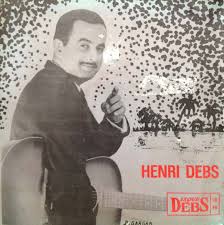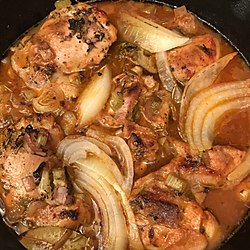Creolization in Caribbean Music -French
The topic of creolization in French-speaking Caribbean music will be studied. Numerous instances of creolization in French Caribbean music are also highlighted in the textbook Tour de Force: A Musical Journey of the Caribbean.
The (Beguine) biguine music, which has its roots in Martinique, is one instance of a creolized musical genre from the French-speaking Caribbean that is mentioned in the text. Biguine combines African rhythms with the Bélé musical style, French ballroom music, and other styles. Some characteristics of this style are described by authors Christine Gangelhoff and Cathleen LeGrand, including syncopated rhythms, the interplay between clarinets and trombones, or string instruments like the guitar and bass.
Below is an image of Biguine singer/player Henri Debs, according to an article found at, https://debs-music-studio.com/en/henri-debs-biography/. He was self-taught and started off on the saxophone before moving on to the guitar and double bass with more than 6000 titles are included in Henri Debs' production, which includes 460/33 turns, 396/45 turns, and 310 CDs. Of all the Caribbean musical productions combined, it has the most extensive catalog.
Below is a video of Henri Debs singing biguine. I chose this video because it perfectly introduces all the nuances that represent biguine music and is fun to listen and dance to.
Video taken from https://www.youtube.com/watch?v=LiJKJi3oP9kBelow is a photo of méringue artist Antoine Rossini Jean-Baptiste, aka Ti Manno.
Video taken from https://www.youtube.com/watch?v=aX4xtofZ4kA
Finally, another example of Creolization in the French speaking Caribbean is seen in the culinary aspect of the country, according to an article found at, https://togetherwomenrise.org/customsandcuisine/customs-and-cuisine-of-haiti/, it mentions that majority of Haitian cooking is based on Creole and French cooking techniques, however over its history, a number of foreign nations who controlled Haiti introduced food and concepts from their own countries. An example of a Haitian dish is shown below. The Poul an sòs (chicken in sauce) which contains chicken, scotch bonnet peppers, red and green peppers, yellow and green onions, parsley, thyme, and tomato paste.
References
Customs and cuisine of Haiti (no date) Together Women Rise. Available at: https://togetherwomenrise.org/customsandcuisine/customs-and-cuisine-of-haiti/ (Accessed: October 19, 2022).
Gangelhoff, C., & LeGrand, C. (2019, December 31). Tour de Force: A Musical Journey of The Caribbean. Sound Caribbean.
Henri Debs Biography (no date) debs. Available at: https://debs-music-studio.com/en/henri-debs-biography/ (Accessed: October 19, 2022).



Comments
Post a Comment